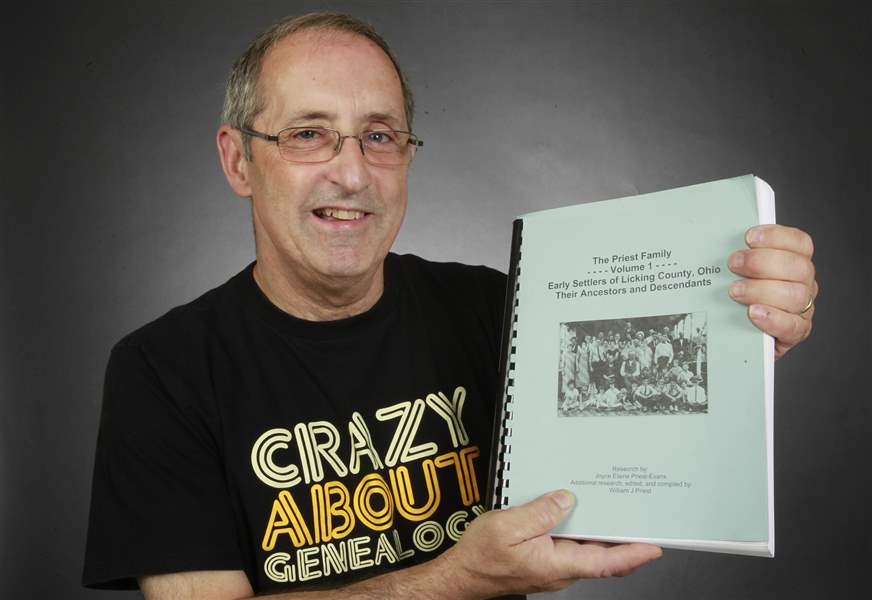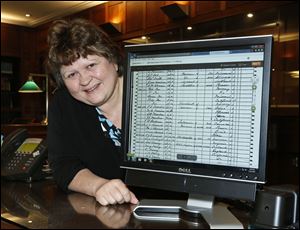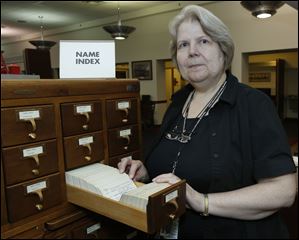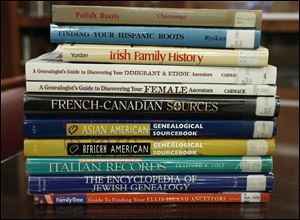
GENEALOGY
Digging for our Roots: With a little work, fascinating family history can come to light
6/29/2014
William Priest has written a book about his family genealogy.
The Blade/Dave Zapotosky
Buy This Image

William Priest has written a book about his family genealogy.
Genealogists are enamored with the notion of the past as a foreign country, something to be excavated and explored.
Whether amateur or experienced, Toledoans have many avenues to learn more about themselves by researching the lives of their ancestors. Consider William J. Priest, who plans to attend the 114th Priest family reunion in eastern Licking County, Ohio, two weeks from today.
“They got there for fighting in the Revolutionary War for Virginia,” said Mr. Priest of Bedford Township. Sixty-seven acres needing to be cleared for farming was awarded to his fifth great-grandfather, John Priest, Sr., who moved with his wife, Catherine, and nine of their 10 offspring to what was then the West.
RELATED: Research finds no link between Toledo mayor, Ireland revolutionary
RELATED: Tips, resources for doing your own genealogical search
Through research, Mr. Priest discovered that the country’s greatest concentration of people named Priest was only 150 miles southeast of Toledo. He’s since gotten to know many of them.
“In Licking County (southeast of Columbus) I’m brought in with open arms,” he said, beaming.
Hunting for information about one’s ancestors strikes a chord for many, particularly as people age and have more leisure time in retirement.
“And perhaps they’re getting closer to their own mortality,” said Mr. Priest, a trustee on the board of the Ohio Genealogical Society. He works as technical director at the Toledo Repertoire Theatre and drives a school bus. “Inevitably, we ask questions after the parents die.”
Companies offering ancestor-search services advertise on television, and the fifth season of Who do You Think You Are?, in which the lineage of celebrities is tracked, will premier on July 23 on TLC.
In addition, avalanches of documents and photographs are being added to web sites all the time, making searches even more do-able. Indeed, computer comfort is almost essential if you’re doing it yourself.
The farthest back Mr. Priest, a self-described computer geek, has traced is to James Priest, his seventh great-grandfather of Virginia, who was born about 1680 and was grandfather to Revolutionary War soldier/Ohio pioneer John Priest, Sr. For him, James Priest represents a brick wall. To travel further back in time, he’ll have to hop the pond to Wales (his best guess) or hire a professional researcher to do legwork for him overseas.
“The best I can hope for is there would be church records,” he said.
First steps

Librarian Irene Martin shows off a 1860 Federal census search in the local history department at the Main Library.
For most people, preliminary information is fairly easily to gather. Get a leg up at a free genealogy workshop at 11 a.m. Sept. 27 in the McMaster Center of the Main Library. Irene Martin will explain how to get the most out of four major data bases: ancestry.com (people can use the library’s subscription for free); familysearch.org (a program of the Church of Jesus Christ of Latter-Day Saints, it includes Ohio death records to 1908 and some Catholic church records); heritagequestonline.com (1790-1930 census, Freedman’s Bank records of former slaves, family histories), and fold3.com (military records). People are asked to register by calling 419-259-5233.
Ms. Martin, the library system’s preservationist, has done genealogy for 38 years. Her colleague, Donna Christian, gives talks on starting a search, African-American genealogy, census research, and immigration records.
“When someone comes in we’ll give them handouts on First Steps in Genealogy, ancestral charts, Researching Obituaries in The Blade, and Genealogy on the Internet,” she said. There’s still lots of info that’s only in books, courthouses, graveyards, and health departments, she noted.
One of America’s favorite hobbies, genealogy triggers our innate curiosity about who we are and where we came from.

Toledo-Lucas County librarian Donna Christian specializes in helping people research their ancestry.
“It’s very much being a detective, a treasure hunt. When people really get into it, it’s the drive to find that next piece of information,” Ms. Christian said. Along the way, they often get hooked on the history of an era or area; it puts their relative’s life in context. “They’ve got a personal connection to it,” she said.
Don Hengen has learned a lot about Quakers; some of his relatives were English Quakers who came to Philadelphia about 1700. “You tend to want to learn about the history of the area because that dictates how your research will go. If, for example, an area hit on hard times, people are likely to move.”
Avid researcher and past-president of the local Genealogy by Computer Society, Mr. Hengen plugs ancestor names into charts on a software program that updates information. Nevertheless, even church records in Europe don’t date much earlier than 1700, he said.
Court records
Ohio probate court records by county go back to 1868; after 1908, many records were kept by county health departments.
Women can be difficult to research because they often used their husband’s first name (Mrs. George Jones), did not own property, didn’t serve in the military, and seldom owned a business. But after 1807, everyone who arrived at these shores by ship should be named on a passenger list, said the library’s Ms. Christian.
There’s information to guide people who know the country their relatives hailed from, even more from places such as Japan or China, where people worship ancestors.
Ms. Christian noted the Sourcebook series for African, Hispanic, Asian, and Native Americans. She recommends Black Roots: A Beginner’s Guide to Tracing the African American Family Tree, by Tony Burroughs, founder of the Center for Black Geneaology.
Mr. Burroughs, of Chicago, has presented day-long workshops in Toledo. He suggests getting started by writing down what you know about yourself and your relatives.

Books on genealogy.
While genealogy looks at lineage, it’s entwined with family history — the qualitative and personal aspects of a life such as likes, dislikes, goals, values, disappointments, what was learned from parents, occupations, wealth, hobbies, and religious beliefs, Mr. Burroughs said.
Visit an older relative’s home asking to see photographs and albums, Bibles, yearbooks, discharge papers, diplomas, funeral programs, and obituaries.
Cemeteries, he said, may be African-American or may have been for whites but with a segregated area for African-Americans. Some census takers may have indicated with an M that a person was mulatto or mixed race; some records have a C before a name indicating the individual was colored. In one state, he found birth and death records for blacks in a different room from whites.
“You have to understand the history of each ethnic group,” he said.
He’s discovered eight generations of his lineage over 251 years via two women: Margaret Goe Hutton and a mulatto named Sarah Goe, born enslaved in 1763 in Maryland.
Mr. Burroughs also has an ancestor who fought in the Battle of Lake Erie with Commodore Oliver Perry. Charles Smothers, born indentured in 1784 in Virginia, joined the army in Tennessee, and later signed on with Perry’s fleet in Ohio. A seventh-generation ancestor on his mother’s side, Mr. Smothers was aboard one of the nine U.S. ships that captured six British vessels during the War of 1812.
Mr. Burroughs came across an 1814 purser’s record requesting bonus pay for all U.S. sailors at that battle; they were to share the proceeds of auctioning what was left of the British fleet, and Mr. Smothers’ share was inked as being $214. His son, Oliver Perry Smothers, fought in the Civil War and is Mr. Burroughs’ great-great grandfather.
“You stand on your ancestors’ shoulders,” Mr. Burroughs said. “We learn about them and we’re able to pay homage and thank them by telling their stories.”
Contact Tahree Lane at tlane@theblade.com and 419-724-6075.